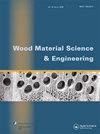用低熔点二元脂肪酸作为相变材料浸渍挪威云杉
IF 2.1
3区 农林科学
Q1 MATERIALS SCIENCE, PAPER & WOOD
引用次数: 2
摘要
摘要用硬脂酸和癸酸的共晶混合物浸渍挪威云杉。二元脂肪酸被用作生物基相变材料(PCM),与木材一起作为建筑构件的潜热储存材料进一步应用。为此,对不同浸渍浓度进行了评价。纯脂肪酸混合物的增重率最高,为124%,pcm浸渍木材的密度从470 kg/m³(未经处理的木材)增加到1045 kg/m³。随着木材中脂肪酸含量的增加,木材的抗压强度和硬度显著提高。显微镜分析证实木细胞内存在PCM。由于相变中的温度变化,处理过的木材在加热和冷却期间也表现出较大的时间延迟。根据木材中脂肪酸的浓度,在24°C至30°C的温度下,熔化过程中的潜热范围为50至125 J/g。这些结果表明,使用癸酸和硬脂酸混合物具有很大的潜力,可以增加木材的储热能力,减少室内空间供暖和制冷的能源消耗。本文章由计算机程序翻译,如有差异,请以英文原文为准。
Impregnation of Norway spruce with low melting-point binary fatty acid as a phase-change material
Abstract
Norway spruce was impregnated with a eutectic mixture of capric acid and stearic acid. The binary fatty acid was used as a bio-based phase-change material (PCM) for further applications with wood as a latent heat-storage material in building components. For this purpose, different concentrations of impregnation were evaluated. The weight-percentage gain of 124% was the highest for the pure fatty acid mixture, and the PCM-impregnated wood increased density from 470 kg/m³ (untreated wood) to 1045 kg/m³. Compressive strength and hardness were significantly elevated with higher content of fatty acids in the wood. Microscopy analysis confirmed the presence of the PCM within the wood cells. The treated wood also exhibited a larger time delay during heating and cooling due to the temperature shift in the phase transition. Depending on the concentration of the fatty acid in the wood, the latent heat during melting ranged from 50 to 125 J/g in the temperature from about 24°C to 30°C. These results suggest that the use of the capric acid and stearic acid mixture has a great potential to increase the heat-storage capacity of wood and reduce energy consumption for heating and cooling indoor spaces.
求助全文
通过发布文献求助,成功后即可免费获取论文全文。
去求助
来源期刊

Wood Material Science & Engineering
Materials Science-General Materials Science
CiteScore
3.90
自引率
13.60%
发文量
131
审稿时长
79 days
期刊介绍:
Wood Material Science and Engineering is a multidisciplinary and international journal with the aim to serve at the forefront of the wood science and technology field. The journal publishes original articles on basic and applied research dealing with:
-Wood material science with emphasis on: water-wood relations, wood durability, wood modification, wood mechanics, wood composites, engineered wood products, energy conversion and eco-efficient wood based products.
-Wood engineering, i.e. the application of the wood material science to designing, processing and manufacturing of forest products and the use of machines and processes for these products. Products of concern are biofuels, sawn wood and further refined products such as structural elements, interior fittings and furnishings. In this aspect the link between the nature of the wood material and the properties of the final wood products in-service and its impact on the environment is of outmost importance.
High quality review papers may also be accepted but the topic should be discussed with the editor before submission.
 求助内容:
求助内容: 应助结果提醒方式:
应助结果提醒方式:


